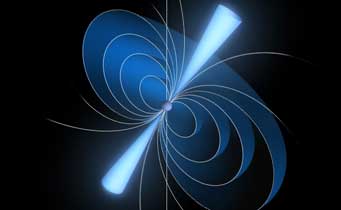Asteroid debris might be bombarding a radio pulsar in the constellation Puppis.
Stellar lighthouses known as pulsars flash from the darkest reaches of space. Rather than warn ships away from rocky shores, these lighthouses cast radiation away from spinning neutron stars — the dense spinning corpses that remain after massive stars explode in fiery supernovae. Pulsars beat with astounding regularity, challenging the accuracy of the best man-made clocks. But one lighthouse located in the constellation Puppis, called PSR J0738-4042, might have encountered an asteroid that has thrown off its ticking.

ESA / ATG medialab
A pulsar’s beat relies on powerful magnetic fields that send jets of particles streaming out along its magnetic poles at speeds close to that of light. As on Earth, the magnetic poles do not necessarily line up with true geographic north and south. So if the alignment is just right such that one jet points at Earth, we’ll detect lighthouse-like flashes as the pulsar spins.
A team of researchers from institutions in the UK, South Africa, and Australia have analyzed 24 years of observations of the pulsar PSR J0738-4042 taken with the Hartebeesthoek Radio Astronomy Observatory and the Parkes Radio Telescope between 1988 and 2012. The team discovered that the pulsar’s rotation rate and pulse shape changed abruptly in September 2005 without good explanation. Paul Brook (University of Oxford, England, and CSIRO, Australia) and colleagues argue that we are witnessing a close encounter with an asteroid or other debris.
While the asteroid-encounter explanation is likely, it’s not ironclad, says Jim Cordes (Cornell University). “It isn’t obvious what else might be going on,” he notes. Quakes and interactions within the pulsar or on its surface could account for changes in its magnetic field and poles or spin axis. The study’s authors plan to investigate alternative explanations in the future.
Asteroids hail from the debris disks that form around neutron stars and pulsars, which are created when material that initially rocketed away during the supernova explosion falls back toward the stellar corpse. Such disks would resemble the protoplanetary disk that once surrounded our Sun, and can hold planets, asteroids, and smaller debris.
If an asteroid within PSR J0738-4042’s debris disk were to embark on a collision course, the pulsar’s intense radiation would vaporize the space rock before it came very close. The dismembered asteroid’s charged particles would flow within the pulsar’s magnetic field and alter the currents there. Since the pulsar’s magnetic field powers the beam of particles shooting out along its magnetic poles (i.e., the stellar lighthouse beam), introducing ionized asteroid guts would set the pulsar’s schedule off-kilter.
The research team chronicled the changes in PSR J0738-4042’s spin rate and pulse pattern using 24 years of data. From that, they calculated that the 2005 deviation from the pulsar’s normal state corresponds to a mass influx of about 1 trillion kilograms (1 billion tons), consistent with the masses measured for asteroids in our solar system.
Studying pulsars helps scientists understand a strange chapter of stellar lives, but there’s also a larger goal. Astronomers have long used pulsars’ extreme gravitational fields and precise, clock-like ticks as a testbed for general relativity, Einstein’s theory of the nature of gravity. Researchers have also used pulsars to explore the magnetic field around our galaxy’s central black hole. “Any unexpected behavior in pulsars is obviously detrimental to such efforts,” Brook comments, “so we need to try and understand the cause of such changes in emission and/or rotation.”
Reference:
P. R. Brook et al., “Evidence of an Asteroid Encountering a Pulsar,” 2014 ApJ, 780, L31.
 0
0
Comments
You must be logged in to post a comment.